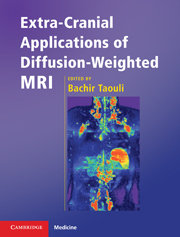Book contents
- Frontmatter
- Contents
- List of contributors
- Preface
- 1 Basic physical principles of body diffusion-weighted MRI
- 2 Diffusion-weighted MRI of the liver
- 3 Diffusion-weighted MRI of diffuse renal disease and kidney transplant
- 4 Diffusion-weighted MRI of focal renal masses
- 5 Diffusion-weighted MRI of the pancreas
- 6 Diffusion-weighted MRI of the prostate
- 7 Breast applications of diffusion-weighted MRI
- 8 Diffusion-weighted MRI of lymph nodes
- 9 Diffusion-weighted MRI of female pelvic tumors
- 10 Diffusion-weighted MRI of the bone marrow and the spine
- 11 Diffusion-weighted MRI of soft tissue tumors
- 12 Evaluation of tumor treatment response with diffusion-weighted MRI
- 13 Diffusion-weighted MRI: future directions
- Index
- References
4 - Diffusion-weighted MRI of focal renal masses
Published online by Cambridge University Press: 10 November 2010
- Frontmatter
- Contents
- List of contributors
- Preface
- 1 Basic physical principles of body diffusion-weighted MRI
- 2 Diffusion-weighted MRI of the liver
- 3 Diffusion-weighted MRI of diffuse renal disease and kidney transplant
- 4 Diffusion-weighted MRI of focal renal masses
- 5 Diffusion-weighted MRI of the pancreas
- 6 Diffusion-weighted MRI of the prostate
- 7 Breast applications of diffusion-weighted MRI
- 8 Diffusion-weighted MRI of lymph nodes
- 9 Diffusion-weighted MRI of female pelvic tumors
- 10 Diffusion-weighted MRI of the bone marrow and the spine
- 11 Diffusion-weighted MRI of soft tissue tumors
- 12 Evaluation of tumor treatment response with diffusion-weighted MRI
- 13 Diffusion-weighted MRI: future directions
- Index
- References
Summary
Introduction
Characterization of renal masses mainly relies on the presence or absence of enhancement on contrast-enhanced computed tomography (CT) or magnetic resonance (MR) imaging. With MRI, enhancement can be assessed by measuring signal intensity changes or visually without or with image subtraction. There is a growing interest in the application of diffusion-weighted MRI (DWI) in body imaging for multiple reasons: DWI can provide structural and functional information without any intravenous (IV) contrast administration, thus it is easy to implement and repeat, and is very attractive in patients at risk for nephrogenic systemic fibrosis (NSF).
The signal and contrast in DWI are based on the thermally driven random motion of water and microcapillary perfusion in tissues, and are usually quantified by calculating the apparent diffusion coefficient (ADC). The ADC is dependent on different factors such as molecular architecture, interactions, and temperature in free fluid. The protons' motion is hindered or restricted by different components such as cell membranes, cellular density, or macromolecules in tissues. This is manifested by an ADC that is reduced from the bulk value. In general, the clinical implications of ADC change depend upon the tissue under investigation; an anomalous rise in ADC can indicate increased edema, cystic changes, and necrosis; while an anomalous reduction in ADC might indicate ischemia, infection, or tumor. As such, diffusion measures should be taken in context with other imaging sequences to ensure an accurate diagnosis.
- Type
- Chapter
- Information
- Extra-Cranial Applications of Diffusion-Weighted MRI , pp. 46 - 54Publisher: Cambridge University PressPrint publication year: 2010



